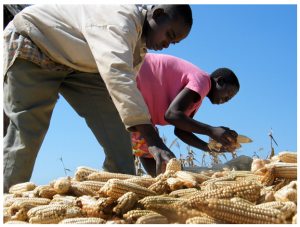 A GM soy and maize farming project in South Africa has ended in disaster for poor farmers. A report on the project says the GM maize and soya failed to address food security needs of the local population. The production methods undermined traditional agricultural production, making the farmers depend on expensive agrochemical inputs.
A GM soy and maize farming project in South Africa has ended in disaster for poor farmers. A report on the project says the GM maize and soya failed to address food security needs of the local population. The production methods undermined traditional agricultural production, making the farmers depend on expensive agrochemical inputs.
Mawande Jack, The New Age, South Africa, 28 June 2011
GM project faces ruin
Non-governmental organisations, academics and farmers have questioned the government’s strategy to increase food security through genetically modified crops in the Eastern Cape.
There was growing concern by the groups about the Eastern Cape government’s claims of assisting poor black farmers under the programme launched in 2003/04 as “green revolution” while more of the farmers faced economic disaster.
The massive state project also includes biodiesel/agrofuel processing in the two industrial development zones (Coega and East London), sugar beet in Cradock and sugarcane production for ethanol in Pondoland.
The government’s ambitious food production programme initially aimed at growing GM crops such as wheat and maize on derelict land in the Eastern Cape.
It also undertook to provide small-scale farmers with subsidies for input supplies, mechanisation, marketing and agro-processing.
Research by the Grahamstown-based Masifunde Education and Development Project Trust, together with Rhodes University’s faculty of humanities and department of sociology, has found that the programme has had disastrous results for farmers in the Amathole district municipality.
“We saw a deepening of poverty and people returning to the land for survival,” one of the researchers attached to Masifunde, Mercia Andrews, said.
Farmers taking part in the project were introduced to farming packages of hybrid and genetically modified seeds, pesticides and fertilisers for the production of monocultures with inputs by private companies linked to the scheme.
The study also generally speaks about concerns about feeding schemes conducted on animals with “alarming results”, which included damage to their internal organs, evidence of weeds and pests that have developed resistance to the GM plants, crops that have been contaminated by pollen from GM crops and of the emergence of big companies that have been able to exert control over local and global food systems as these crops were patented.
Farmers in the province who took part in the scheme were to be assisted in becoming “fully fledged business entities” like co-ops, company groups and farmers associations.
The Siyakhula Food Production Programme and Farmers Organisation Development were the main drivers of this green revolution in order to attain these objectives.
These were also to address local and provincial food security needs, poverty alleviation and promote usage of conservation cropping practices including minimum tillage.
The government vigorously encouraged the mostly poor black farmers to produce genetically modified maize and soya but those were not crops that addressed food security needs of the local population.
What compounded matters was that the production methods undermined traditional agricultural production “making these farmers depend on expensive agro-chemical inputs by the private sector”.
Government officials admitted to problems faced by this project and that it was compelled to include other crops than grains, such as citrus and deciduous fruit.
In Amathole, the department hoped to boost the scheme by an increasing infrastructure investment, cultivating 3000 hectares, launching the Siyazondla Homestead Food Production, revitalising irrigation schemes, improving human resources and promoting cooperative models of agricultural economic development with emphasis on women, youths and people with disabilities.
Farmers who spoke of their experiences in the research were villagers from Mgababa, Prudhoe, Peelton and Nxarhuni in the Amathole area. The villagers claim they were never told they would be growing GM maize, leading many to drop out. Others felt exploited by private companies as they were not getting what they hoped to achieve.
Moreover, contracts were written in English and no consultation and training took place.
{sharethis}





Leave A Comment
You must be logged in to post a comment.